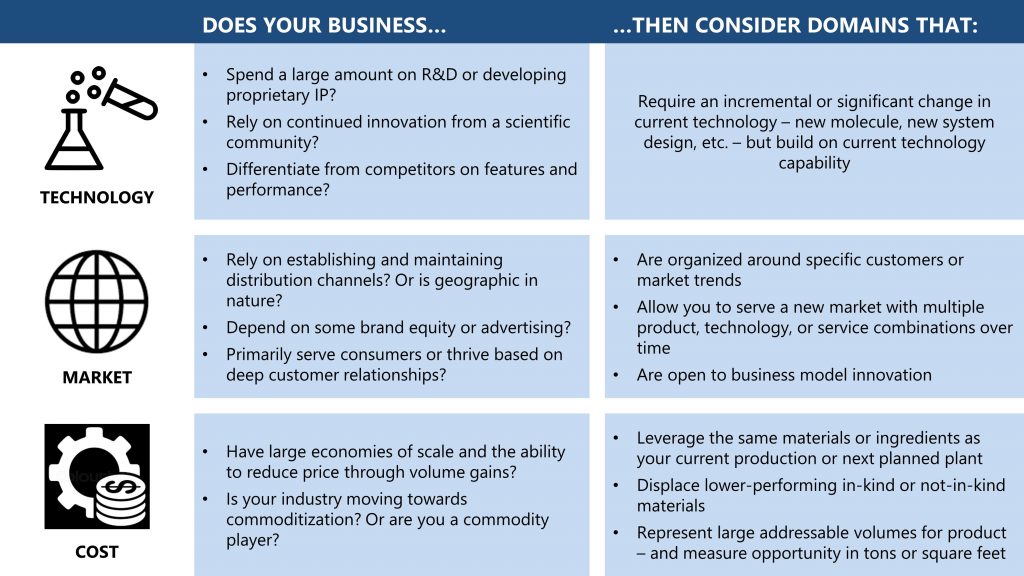In innovation, as in ballroom dance, starting on the right foot is key. There are many other elements of a good dance, of course—grace, flexibility, rhythm, etc.—just as there are many other factors that play into successful innovation; however, many of the stumbles, slip-ups, and collisions that happen later in the process can be traced back to that very first step. In this blog, I’ll discuss how to put your best foot forward with well-defined strategic growth domains, so that you can move your organization into new spaces with grace and purpose.
What is a strategic growth domain?
Individual interesting ideas can be great for growth, but unless your company is lucky and hits a lot of homeruns, the investment can be risky. Current thinking across many industries is to create “strategic growth domains” or “platforms” to help hedge risk of investing in singular ideas and create opportunities to reap the benefits of broader market or technology understanding across a portfolio of possible wins.
There doesn’t seem to be much dispute about the value of pursuing growth opportunities in attractively packaged clusters. Most R&D, marketing, and business unit heads readily understand the value of consolidated effort. However, there is outstanding debate over how to create winning growth platforms—it’s all well and good to group things together, but what’s the best organizing principle?
First, some basics. Strategic growth domains should be focused and connected with organizational objectives for financial impact and timing. Good domains are:
- Explainable: To infuse your organization with inspiration, you need to be able to describe your vision for growth to both management and those in execution roles. To this end, a domain must offer an opportunity big enough to be attractive, but tactical enough to execute on. It can be tempting to latch onto broad megatrends or emotional buzzwords in developing concepts for domains, but unless those ideas are clearly tied to specific customers, channels, and products, your organization will struggle to follow where you lead.
- Differentiated: In order to win, you need something that your competitors do not have now. You need a winning angle. You need your own special rhythm.
- Defendable: In order to sustain your wins, you need your winning angle to be hard to attack. As my colleague Bryn discussed in a previous post, many innovative companies defend themselves with longstanding technology moats; however, if deep IP and trade secrets are not part of your organization’s assets, you’ll have to incorporate some other means of protecting your position.
- Achievable: A strategic growth domain cannot just be an interesting idea; it must also play to your strengths. A platform that is tied to capabilities you already have—whether that’s a winning distribution channel, untouchable IP, an advantaged manufacturing cost position, or deep customer relationships—will have broader, more sustained, and more timely impact on your bottom line.
What makes a winning domain?
The mistake many make in defining strategic growth domains is trying to intersect too many variables—technology, innovation, acquisitions, and customers, a new market segment, etc.—all at once. As A.G. Lafley writes in “Playing to Win,” strategy is about choice. To get to a growth platform that will deliver results, you need to choose just one or two of those highest-priority variables to focus on.

So which are the highest priorities? Well, there is no one-size-fits-all platforming scheme. You need to make decisions based on your particular organization’s best foot forward—in this case, your primary axis of competition. If R&D is your organization’s heart and soul, start there. If customers and channel access are your competitive mainstays, then aim for growth in that direction.

This is not to say that if you compete primarily on IP, you cannot access new customer segments, or that if you have strong defense of your customer access, you cannot adopt new technology. Rather, to maximize success and achieve more profitable growth more quickly, you should play first to your competitive strengths, and organize the rest of your goals around those. There’s a lot you can do once you’re moving around in a new space; just make sure you start off on the right foot.
Find out how Newry can help your organization move smarter to move faster. Get traction in your market.
